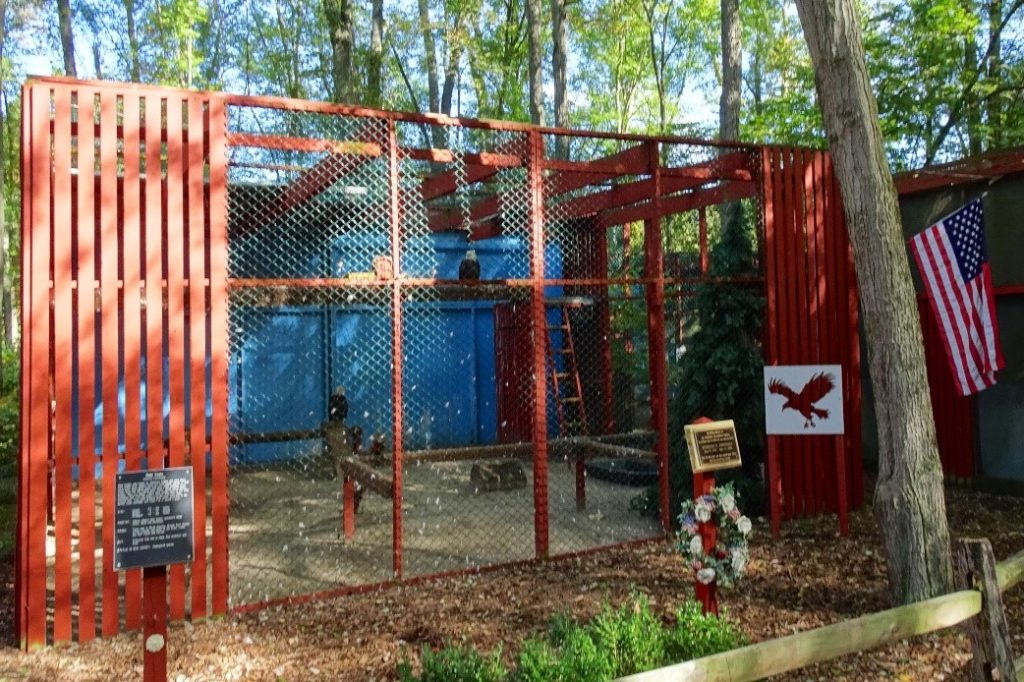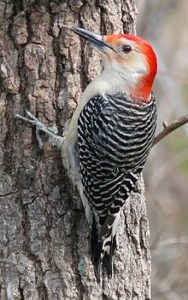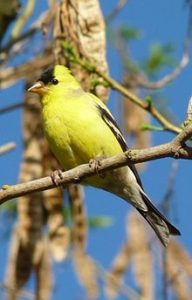Bird Watching in New Jersey

Though you may not initially suspect it, New Jersey is considered by many to provide some of the best bird watching in the country. The spring brings in some of the most colorful birds on the continent, as New Jersey is in the middle of many migratory birds’ paths. As such, it means that New Jersey allows for excellent bird watching — particularly in the spring. In the spring, birds generally have much brighter colored feathers and are a lot more noticeable, as they’re trying to secure a mate for the coming year.
Read on to learn more about some of the fantastic bird watching available to Applewood residents!
What is New Jersey’s State Bird?
The state bird of New Jersey is the American Goldfinch.
Have you seen one before?
This bird is easily identifiable by its bright yellow coloring, black marking and streaks of white on its head and  wings. Interestingly, the American Goldfinch has an enormous territory and is also the state bird of Iowa & Washington, though in Washington it is known as a Willow Goldfinch. Year-round, the American Goldfinch can be found throughout the northern half of the United States. During the winter, the goldfinch tends to travel from the northern section of the continent to the south — a true snow bird. The habit of the American Goldfinch is not currently threatened by human activity. In fact, our involvement has significantly helped the bird thrive. Deforestation across the United States, which has proved damaging for other species, has led to the creation of open meadow areas — the finch’s preferred habitat. The finch is also attracted to bird feeders, which considerably helps to increase the rate of survival for the bird in residential areas.
wings. Interestingly, the American Goldfinch has an enormous territory and is also the state bird of Iowa & Washington, though in Washington it is known as a Willow Goldfinch. Year-round, the American Goldfinch can be found throughout the northern half of the United States. During the winter, the goldfinch tends to travel from the northern section of the continent to the south — a true snow bird. The habit of the American Goldfinch is not currently threatened by human activity. In fact, our involvement has significantly helped the bird thrive. Deforestation across the United States, which has proved damaging for other species, has led to the creation of open meadow areas — the finch’s preferred habitat. The finch is also attracted to bird feeders, which considerably helps to increase the rate of survival for the bird in residential areas.
How many types of birds are in New Jersey?
New Jersey is frequented by a diverse amount of different birds. The state regularly sees roughly 475 species that have been successful in establishing self-sustaining populations in the wild, per the New Jersey Bird Records Committee. This figure includes species that have been introduced into the area, as well. New Jersey’s range of birds is about as diverse as the number of birds that have established successful populations in the state. For instance, there are 45 different types of ducks or duck-like waterfowl in the state alone — and this doesn’t include birds like loons, grebes, pelicans, or other near-water birds. The state is also home to many different birds of prey, including falcons, hawks, eagles, and even 9 different species of owl.
Best places in New Jersey for bird watching?
During the migratory months, most of New Jersey is home to a wide variety of highly colorful birds, stopping through the state to rest and breed on their way to warmer climates. During their migration, birds are considerably more worried about obtaining a mate, as opposed to avoiding predators, making it much less difficult to find otherwise hard-to-see birds. Just be sure to bring your binoculars!
While the whole of New Jersey has some excellent spots for bird watching, these five locations are in a league of their own:
- Garret Mountain, Woodland Park: We’re not the only ones that think Garret Mountain is excellent for bird watching. In fact, the New Jersey Audubon Society indicates that Garret Mountain is more than just one of the best spots in the state, but one of the best bird watching locations in the entire country. What makes it so great is that Garret Mountain essentially creates a funneling effect, forcing migratory birds to take a break at Garret Mountain to rest and eat before they continue on their way.
- Sandy Hook: Sandy Hook is one of the best places in the state for bird watching for nearly the same reason that Garret Mountain is so excellent. Birds coming from the east coast tend to get stuck at the peninsula and choose to rest on the shores of Sandy Hook, rather than attempt to cross such a vast body of water without proper food or rest. As such, the same sort of funneling effect occurs, making Sandy Hook incredible for watching migratory birds. But the area is much more than that — it is also one of the best places in the state to see shorebirds.
- Brigantine: Formally declared a protected tidal wetland and shallow bay habitat for migratory water birds, this area was originally two distinct protected areas. In 1984, they were combined under the title Forsythe Refuge. The refuge is found in one of the Atlantic Flyway’s busiest flight paths, which means that Brigantine is, more or less, ‘bird Valhalla’. If you like shorebirds and waterfowl, then this is the place for you. The area was established to protect birds, including vast groups of ducks and gulls, which you’re highly likely to see at Brigantine. Other species that you may see here include the American Bald Eagle and the fastest bird in the sky– the Peregrine Falcon.
- The Meadowlands: Located just four miles from the largest city in the nation, New York, and just off the coast of the Hackensack River watershed, you’ll find one of the best bird havens. The New Jersey Meadowlands feature 32 square miles with over 1,1168 acres of land accessible to the public — including viewing platforms and walking and paddling trails. Over 280 different bird species have been reported here, which is another major stop along the Atlantic Flyway. Here, you’ll predominantly find waterfowl, raptors, and gulls in large numbers during the winter and a large variety of waterfowl, shorebirds, wading birds, and song birds throughout the spring and summer.
- The Raptor Trust: The Raptor Trust, established over 30 years ago, is a national leader in raptor conservation and avian rehabilitation. Open seven days a week, visitors can experience a unique opportunity not available in most of New Jersey. Visitors can get up close and view many hawks, owls, falcons, and eagles who are permanent residents of the facility. While there is no charge to visit, the Raptor Trust does encourage a $2.00 donation, as it receives no government support and fully relies on private contributions to cover the day-to-day costs of the facility.

Most common birds in New Jersey
New Jersey plays host to so many different birds that if you’re looking to identify them all, we recommend checking out the book Birds of New Jersey: Field Guide by Stan Tekiela. This guidebook is the perfect addition to any birding trip in New Jersey. It’s thorough, has easy to understand explanations, and makes bird identification simple.
But for those of you who are simply curious about identifying the birds you’re seeing in your backyard, we’ve put together this handy identification table, which shows identifying information for the 10 most common birds in all of New Jersey.
 |
Red Bellied Woodpecker: |
Primarily light gray on the face and underparts, adult male Red Bellied Woodpeckers have a red cap that extends from the bill to their nape, while females have a red patch on the nape and right above the bill. While it is difficult to see, these woodpeckers are named for the reddish tinge on their bellies. |
 |
Tufted Titmouse |
The Tufted Titmouse can be identified by its grey upper body, with white underparts and a white face. The Tufted Titmouse also has a dark forehead and a short bill with deep red colored flanks. |
 |
American Goldfinch |
Interestingly, the American Goldfinch is the only finch in its subfamily that undergoes a full molt throughout the seasons. This means that the male is a vibrant yellow during the summer, offset by streaks of black and grey, but more of an olive color during the winter. The female American Goldfinch exhibits a darker, duller, yellow-brown shade throughout the year, which brightens during the summer. |
 |
Downy Woodpecker |
The Downy Woodpecker is known for being the smallest species of woodpecker in all of North America. This little guy can be identified by its primarily black feathers, with spots of white on its back, throat, and wings. There is typically a white bar above the eye and one below as well. Downy Woodpeckers tend to have a black tail with white feathers too. Adult male Downy Woodpeckers can be identified by the patch of red on the back of their heads, while juveniles still have a full red cap. |
 |
Cedar Waxwing |
The Cedar Waxwing is a medium sized and mostly brown bird, found in open wooded areas. Their feathers have a bit of a silky shine on them, with hints of brown, gray, and lemon-yellow. The Cedar Waxwing also has a yellow crest, with a black mask and red ‘wax droplets’ on the wing feathers. Their wings are typically very pointed and broad, similar to that of a starlings’, but the tail of a Cedar Waxwing is usually a good giveaway to the type of bird that it is. Their tails are usually a yellowish or orange color, depending on the birds’ diet. |
 |
Snowy Egret: |
At first glance, the Snowy Egret is easy to mistake for a small heron, but the Snowy Egret is a bird of its own. Standing approximately 2 feet tall, Snowy Egrets are identifiable by their long black legs, slim black bill, and long yellow feet. The area in front of the Snowy Egret’s eyes is typically yellow, but during mating season this area turns red and the adults also gain somewhat ‘shaggy’ looking feathers on their backs. Juvenile Snowy Egrets are easily identifiable as well, as they have a paler bill, with a green or yellow line running down the back of their legs. |
 |
Gray Catbird |
This medium sized bird is identifiable by its nearly pure lead-gray coloring. Only the head and tail are darker, with the tail having some black and rust colored areas. The eyes, legs, and feet of the Catbird are also blackish. There is no way to distinguish male from female Catbirds by looks, but you can by differences in behavior. |
 |
The Cooper’s Hawk: |
The Cooper’s Hawk is one of the rarest birds in all New Jersey. These small hawks can be identified by their rounded wings, red eyes, and black skull cap. Adult Cooper’s Hawks can also be identified by their red eyes and blue-gray tail, barred with black bands. Immature Cooper’s Hawks can be identified by their yellow eyes, with a brown cap and primarily brown coloring. When flying, the Cooper’s Hawk appears to be very long-necked and has been described to look a bit like a “flying cross”. The Cooper’s Hawk is primarily found flying with quick, consecutive wing beats, though they are known to glide as well. |
 |
Red-shouldered Hawk |
The Red Shouldered Hawk, a medium sized hawk, remains in New Jersey year-round. It can be identified by its reddish, brownish chest and head, with a pale belly, adorned with reddish bars. Their tails are quite long, darkly colored, and marked with narrow white stripes. Their red shoulders are visible only when the birds are perched. Red Shouldered Hawks tend to have long yellow legs and hooked beaks. |
 |
Great Horned Owl |
The most common owl in New Jersey, and in Monmouth County, is the Great Horned Owl. The Great Horned Owl is easily distinguishable by its mottled brown appearance, broken up by patches of white on its chest and neck. The Great Horned Owl also has a large face, framed by small ‘horns’ or tufts of feathers. An interesting note about this particular owl is that the Great Horned Owl has the largest feathers on its feet of any owl, second only to the Snowy Owl. |
Go bird watching in Freehold, NJ
So what are you waiting for?
Get out!
Explore nature!
With 470 different species of bird right here in New Jersey, we’re sure that you’ll see something to make it all worth it. You may even see some of the birds mentioned above while on a tour of our campus! We just recommend that you bring a notebook and your binoculars!